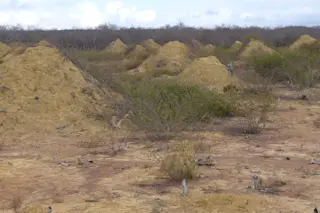Two hundred million mounds of dirt dot an area about the size of Great Britain in a tropical forest in northeastern Brazil. The cone-shaped dirt piles are roughly twice as tall as the average American man and stretch 30 feet across at the base. The mounds, the work of countless generations of termites, rise from the earth every 65 feet or so and are visible from space.
These mounds, as tall as skyscrapers to the insects that made them, aren’t just massive, they’re also incredibly ancient, an international team of researchers has found. The artificial hills have existed for nearly as long as the Pyramids of Giza.
“This is apparently the world’s most extensive bioengineering effort by a single insect species,” Roy Funch, a biologist at the Universidade Estadual de Feira de Santana in Brazil, who co-led the new research, said in a statement. “Perhaps most exciting of all — ...














